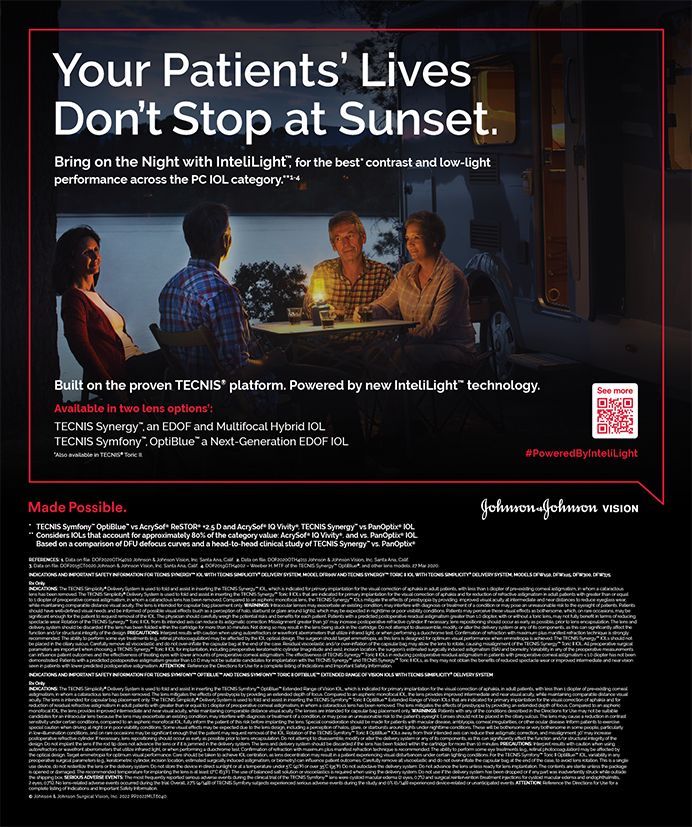

CORNEAL THICKNESS PROFILE AND POSTERIOR CORNEAL ASTIGMATISM IN NORMAL CORNEAS
Ueno Y, Hiraoka T, Miyazaki M, et al1
Abstract Summary
Ueno et al examined the influence of the corneal thickness profile on posterior corneal astigmatism (PA). The prospective, observational study included 418 healthy participants. The investigators measured the anterior and posterior corneal surface using three-dimensional swept-source anterior segment optical coherence tomography (SS-1000 Casia; Tomey). Additionally, they measured the pericentral corneal thickness (PCT) in four quadrants and calculated the average vertical and horizontal PCTs. The PA was calculated twice: predicted PA was based on the anterior corneal curvature and keratometric index, and measured PA was derived from the direct measurement of the curvature of the posterior cornea.
Ueno et al found a difference between the predicted and measured PA. The PCT was significantly greater in the vertical (546 ±31.8 μm) than in the horizontal direction (542.6 ±31.7 μm; P < .0001), and the difference between them was significantly correlated with subjects’ age (r = 0.518; P < .0001). The difference between the assumed and actual PA correlated significantly with the discrepancy between vertical and horizontal PCT (r = 0.819; P < .0001) as well as subjects’ age (r = 0.533; P < .0001).
DISCUSSION
Anterior segment spectral-domain optical coherence tomography has been used successfully to measure the posterior corneal surface.2 Two studies have shown similar reproducibility for anterior segment optical coherence tomography compared to Scheimpflug photography and better reproducibility coefficients and intraclass correlation coefficients than with scanning-slit topography.3,4 Most of the current studies in the literature focus on the central corneal thickness as opposed to PCT, which is likely due to the difficulty of measuring PCT in situ. Existing studies have shown that PCT is thicker in the superior direction, but this research did not compare PCT across quadrants.5-8
Ueno et al found that the cornea was thicker in the vertical than the horizontal direction. This discovery may explain why earlier studies reported that the posterior corneal surface has more against-the-rule (ATR) astigmatism than the anterior corneal surface. Additionally, Ueno et al found that, with age, the PCT in three of the four quadrants (inferior, nasal, and temporal) showed a significant negative correlation with aging. The investigators also confirmed the findings of Koch et al9 that “actual PA was greater in eyes with anterior [with-the-rule] astigmatism than in those with ATR.”1 Additionally, Koch and colleagues found that the vertical corneal thickness was significantly thicker than the horizontal thickness. Importantly, Ueno et al reported that the “magnitude of vector difference between the assumed and the actual PA was significantly correlated with the difference in the vertical and horizontal corneal thickness.”1
The explanation for this difference between assumed and actual keratometric astigmatism is theorized to be due to the negative power of the posterior corneal surface.9,10 This negative power means that a steeper vertical posterior corneal curvature manifests itself as increased ATR astigmatism, accounting for the difference between assumed and actual keratometric astigmatism. Because PCT decreases with age, this difference between predicted and measured PA becomes more pronounced in older patients.
One of the major limitations of Ueno and colleagues’ study is the lack of reliable methods by which to measure the posterior cornea.10 Therefore, further studies on the refractive power of the posterior cornea are needed to confirm these findings. A longitudinal study that demonstrates the natural age-related changes of the corneal curvature in vivo would be ideal. Confirmation of the research by Ueno et al would have significant implications for IOL selection for cataract patients. A more precise measure of the refractive power of the entire cornea would result in better refractive correction after cataract and lens replacement surgeries, leading to better outcomes.
1. Ueno Y, Hiraoka T, Miyazaki M, et al. Corneal thickness profile and posterior corneal astigmatism in normal corneas. Ophthalmology. 2015;122:1072-1078.
2. Ueno Y, Hiraoka T, Beheregaray S, et al. Age-related changes in anterior, posterior, and total corneal astigmatism. J Refract Surg. 2014;30:192-197.
3. Jhanji V, Yang B, Yu M, et al. Corneal thickness and elevation measurements using swept-source optical coherence tomography and slit scanning topography in normal and keratoconic eyes. Clin Experiment Ophthalmol. 2013;41:735-745.
4. Szalai E, Berta A, Hassan Z, Módis L. Reliability and repeatability of swept-source Fourier-domain optical coherence tomography and Scheimpflug imaging in keratoconus. J Cataract Refract Surg. 2012;38:485-494.
5. Khoramnia R, Rabsilber TM, Auffarth GU. Central and peripheral pachymetry measurements according to age using the Pentacam rotating Scheimpflug camera. J Cataract Refract Surg. 2007;33:830-836.
6. Jin BE, Wulff H, Widdicombe JH, et al. A simple device to illustrate the Einthoven triangle. Adv Physiol Educ. 2012;36:319-324.
7. Li Y, Tang M, Zhang X, et al. Pachymetric mapping with Fourier-domain optical coherence tomography. J Cataract Refract Surg. 2010;36:826-831.
8. Huang J, Ding X, Savini G, et al. A comparison between Scheimpflug imaging and optical coherence tomography in measuring corneal thickness. Ophthalmology. 2013;120:1951-1958.
9. Koch DD, Ali SF, Weikert MP, et al. Contribution of posterior corneal astigmatism to total corneal astigmatism. J Cataract Refract Surg. 2012;38:2080-2087.
10. Koch DD. The posterior cornea: hiding in plain sight. Ophthalmology. 2015;122:1070-1071.
In Response
By Evan Zeldin, BA, and Karolinne Maia Rocha, MD, PhD
Douglas Koch, MD, published a response to the findings by Ueno et al in Ophthalmology titled, “The Posterior Cornea: Hiding in Plain Sight.”1 Koch highlights a discrepancy between his own research and that of Ueno and colleagues.2 The latter found that the cornea is thicker along the vertical meridian than the horizontal meridian and that this difference increases with age. Koch reported essentially no change in the magnitude of posterior corneal astigmatism with age.3 Koch calls for further studies to elucidate this discrepancy.
Until now, there has not been a reliable method by which to measure the astigmatism of the posterior cornea. Slit-scan imaging, Scheimpflug imaging, swept-source anterior segment optical coherence tomography, and reflection topography have been shown to be effective in measuring the curvature of the posterior cornea.1-4 Measuring the posterior cornea has been key to solving the mystery behind the difference in refraction between the refractive astigmatism and the anterior corneal astigmatism of the eye.
Recently, it has been shown that there is more refraction in eyes with against-the-rule (ATR) astigmatism than with-the-rule (WTR) astigmatism.3,4 It was assumed that the posterior cornea could not have accounted for this difference; however, imaging technology proves that this is not the case. Instead of ignoring the posterior cornea, Koch suggests that posterior corneal astigmatism is clinically relevant.3,4 Imaging scans have shown that the posterior cornea tends to be steeper along the vertical axis and that the amount of posterior corneal astigmatism fluctuates with the degree of anterior corneal astigmatism.3,4 With increasing WTR astigmatism, there is an increase in posterior corneal astigmatism, but with increasing ATR astigmatism, the posterior corneal astigmatism does not increase.1 Koch et al have shown mean prediction errors of 0.57 D in the WTR group and 0.12 D in the ATR group using Scheimpflug technology.3,4 Future studies on the posterior cornea are especially important for more precise selection of IOL power in cataract surgery to achieve better surgical outcomes and satisfied patients.
1. Koch D. The posterior cornea: hiding in plain sight. Ophthalmology.2015;122(6):1070-1071.
2. Ueno Y, Hiraoka T, Miyazaki M, et al. Corneal thickness profile and posterior corneal astigmatism in normal corneas. Ophthalmology. 2015;122:1072-1078.
3. Koch, DD, Ali SF, Weikert MP, et al. Contribution of posterior corneal astigmatism to total corneal astigmatism. J Cataract Refract Surg. 2012;38:2080-2087.
4. Koch DD, Jenkins R, Weikert MP, et al. Correcting astigmatism with toric intraocular lenses: the effect of posterior corneal astigmatism. J Cataract Refract Surg. 2013;39:1803-1809.
Section Editor Edward Manche, MD
• director, cornea and refractive surgery, Stanford Eye Laser Center
• professor of ophthalmology at the Stanford University School of Medicine, Stanford, California
• edward.manche@stanford.edu
Karolinne Maia Rocha, MD, PhD
• assistant professor, Cornea, Cataract & Refractive Surgery, Medical University of South Carolina, Storm Eye Institute, Charleston, South Carolina
• karolinnemaia@gmail.com
• financial interest: none acknowledged
Evan Zeldin, BA
• Medical University of South Carolina, Charleston, South Carolina
• zeldin@musc.edu
• financial interest: none acknowledged


